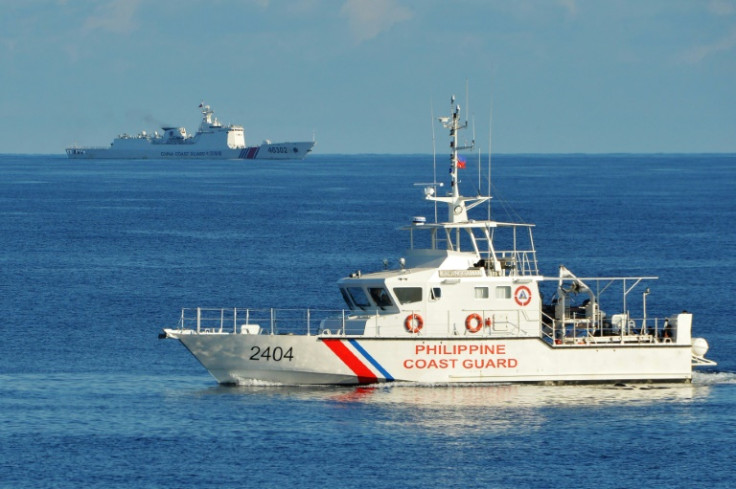Scarborough Shoal: Expert Says South China Sea Version Of 2020 Sino-India Himalayan Clash Possible

KEY POINTS
- A 'violent incident' is likely at Scarborough Shoal if China continues its aggression: CSIS' Gregory B. Poling
- Philippine Coast Guard removed a 'floating barrier' installed by Chinese maritime militia
- China warned Manila not to 'stir up trouble' in the disputed waters
More than a decade after a standoff between Chinese and Philippine warships, tensions at the Scarborough Shoal in the South China Sea are rising again. The latest incident at the atoll, which both China and Philippines lay claim to, are over a floating barrier installed by the Chinese Coast Guard (CCG) last week to prevent Philippine fishermen from fishing there. The fear is whether the tensions could spiral out into a clash between the two countries' forces in the South China Sea.
"If China continues to employ its coast guard and militia vessels to intentionally create risks of collision, then yes, it will likely eventually lead to a violent incident," Gregory B. Poling, head of the Southeast Asia Program and Asia Maritime Transparency Initiative at the Center for Strategic and International Studies (CSIS) told International Business Times.
The fears are real. Something similar had played out in the Himalayas three years ago. China's attempts at a creeping takeover of disputed territory, and India's muscular military response, had led to tensions that quickly devolved into deadly clashes between Chinese and Indian troops at their shared Himalayan border in mid-June 2020.
It was a vicious fight using just clubs studded with nails, knives, rocks, and even bare fists. But no shots were fired, underscoring how neither country wanted an escalation into an all out shooting war.
The Indian army lost 20 soldiers in the fight. In early 2021 China revealed that it had lost four soldiers in the clash. But various reports put the Chinese fatalities at anywhere between 35 and 43 soldiers.
Marine life-rich Scarborough Shoal first saw tensions at current levels in April 2012 after Filipino sailors discovered large numbers of illegally harvested coral, live sharks and giant clams inside a Chinese vessel. An unarmed standoff between Philippine and Chinese vessels that ensued lasted more than two months, before Philippine boats withdrew from the territory. China has since taken control of the reef, which is located some 200 kms (124 miles) off the Philippines' Zambales and within its exclusive economic zone (EEZ).
Poling, who authored "The South China Sea in Focus: Clarifying the Limits of Maritime Dispute," noted that it is likely the two sides will work hard to keep the tensions from escalating out of hand.
So far, the two countries have only been exchanging words after the Philippine Coast Guard (PCG) accused the Chinese maritime militia of installing the 300-meter "floating barrier." The PCG said Monday that it had removed the "hazardous floating barrier" in compliance to President Ferdinand "Bongbong" Marcos Jr.'s instructions.
Philippine Coast Guard Successfully Removes Hazardous Floating Barrier in Compliance with Presidential Instruction
— Jay Tarriela (@jaytaryela) September 25, 2023
In compliance with the instruction of the President, the Chairman, National Task Force for the West Philippine Sea (NTF-WPS), Sec. Eduardo Año, has directed the… pic.twitter.com/loeeFm45sU
In reply, Chinese foreign ministry spokesperson Wang Wenbin warned Tuesday that Manila should not "stir up trouble" in the reefs. He said Beijing "firmly upholds the sovereignty and maritime rights and interests of the Huangyan island," its name for the Scarborough shoal."
Manila "has correctly assessed that China doesn't want to escalate to armed force," Poling said, pointing out that China has not taken any aggressive steps other than complaining about the Philippines' supposed intrusion into the area.
During a Philippine senate hearing Tuesday, some lawmakers expressed outrage over the barrier. Sen. Joel Villanueva said he was "totally disgusted" with the level of "disrespect" shown by the Chinese side. Sen. Ronald "Bato" Dela Rosa said he was "sick and tired" of Manila lodging diplomatic protests over China's "bullying" in the West Philippine Sea.
Maghahain ba ng diplomatic protest ang Pilipinas kaugnay ng paglalagay ng Tsina ng floating barrier sa Scarborough Shoal? Para sa isang senador, lumang diskarte na iyan.
— CNN Philippines (@cnnphilippines) September 26, 2023
Ang detalye sa report ni @eimorpsantos. pic.twitter.com/69q6ioDYKD
Despite the lawmakers' frustration, they stopped short of recommending taking steps that could further escalate tensions. But the Marcos administration also appears to be much bolder than the previous one under Rodrigo Duterte in handling the dispute.
Manila's growing confidence can be linked to its strengthening ties with Washington, Poling said. "The Marcos administration seems to assess that China doesn't want to escalate out of the 'grey zone' of coercion to overt military force, and that the United States' commitment to defend Filipinos if that were to happen is a sufficient deterrent."
Earlier this month, the U.S. Navy conducted a joint sail with the Philippine Navy across parts of the West Philippine Sea in a bid to enhance "interoperability between the two navies."
The two sides are also reportedly in talks to build a civilian port on the remote Philippine islands flanking Taiwan, specifically in the northern Batanes Islands, which is only about 200 kms from Taiwan. China claims the independetly ruled Taiwan as its own and President Xi Jinping has not ruled out the use of force in bringing it under Chinese rule. But the Biden administration has said it will defend Taiwan, vexing the Chinese leadership.
Meanwhile, China continues to reject the 2016 international arbitral ruling that ruled in favor of the Philippines after Manila lodged a challenge in 2013 over Scarborough Shoal's seizure. China has laid claim to virtually the entire South China Sea and recently reinforced its claims with a new map that replaced its infamous 9-dash line with a new, larger 10-dash line.
© Copyright IBTimes 2024. All rights reserved.






















